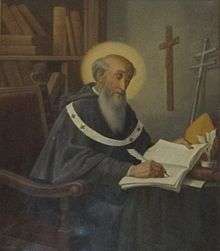Giacomo da Viterbo
| Blessed Giacomo da Viterbo O.S.A. | |
|---|---|
| Archbishop of Naples | |
 Painting in Viterbo. | |
| Church | Roman Catholic Church |
| Archdiocese | Naples |
| Metropolis | Naples |
| See | Naples |
| Appointed | 12 December 1302 |
| Installed | 1303 |
| Term ended | 1307 |
| Predecessor | Giovanni de Alatre |
| Successor | Monaldo Monaldeschi |
| Orders | |
| Consecration | 1302 |
| Rank | Archbishop |
| Personal details | |
| Birth name | Giacomo Capocci |
| Born |
c. 1255 Viterbo, Papal States |
| Died |
c. 1307 Naples, Kingdom of Naples |
| Nationality | Italian |
| Denomination | Roman Catholic |
| Previous post | Archbishop of Benevento (1302) |
| Alma mater | University of Paris |
| Sainthood | |
| Feast day | 4 June |
| Venerated in | Roman Catholic Church |
| Beatified |
14 June 1911 Saint Peter's Basilica, Kingdom of Italy by Pope Pius X |
| Attributes |
|
| Patronage |
|
Blessed Giacomo da Viterbo (c. 1255 – 1307), born Giacomo Capocci (nicknamed "Doctor speculativus") was an Italian Roman Catholic Augustinian friar and a student of Giles of Rome.[1]
He was born in Viterbo in the Papal States in 1255. He was a professor of theological studies at the University of Paris from 1293 to 1300. He wrote on the relationship between ecclesiastical and temporal power in his book "De Regimine Christiano". It argued that although human power alone is lawful it could be perfected through the influence of a spiritual power alone. Walter Ullmann[2] stated that it was the first "exposition of the concept of the Church".
He became the Archbishop of Benevento after Pope Boniface VIII appointed him in 1302 and he later the Archbishop of Naples in a formal installment in 1303 following his 12 December 1302 appointment. In 1306 he received the task of Pope Clement V in overseeing the cause of canonization of Pope Celestine V. He died in Naples in 1308.
Pope Pius X beatified him on 14 June 1914.
References
- ↑ Antony Black, Political Thought in Europe 1250-1450 (1992, p.49): [James and Giles, i.e. Aegidius] were members of the order of Eremitical Augustinians, both had studied at Paris (Aegidius probably under Aquinas, James probably under Aegidius), and rose to be archbishops.
- ↑ Medieval Foundations of Renaissance Humanism, p.144
Sources
- H. X. Arquillière (1926), Les plus ancien traité de l'Eglise: J., De regimine Christiano
- R. W. Dyson (1995), James of Viterbo: On Christian Government (De regimine Christiano)
External links
- Saints SQPN
- Life of Bl. James of Viterbo (Augustinians of the Midwest)
- James of Viterbo – University of Notre Dame
- Biography (Italian language)
- Michael Tilly (1990). "Jakob von Viterbo (Giacomo di Cappocio), Beiname "Doctor speculativus"". In Bautz, Friedrich Wilhelm. Biographisch-Bibliographisches Kirchenlexikon (BBKL) (in German). 2. Hamm: Bautz. cols. 1492–1493. ISBN 3-88309-032-8.